Samsung Galaxy S 4 Review - Part 1
by Brian Klug on April 24, 2013 12:01 AM ESTBattery Life and Charge Time
The Galaxy S 4 features a removable 9.88Wh battery with 3.8V chemistry. The battery design is par for the course for any high end smartphone, but the fact that it's removable remains a staple of the Galaxy S design. Whether or not the bulk of consumers actually use the flexiblity offered by a removable battery is up for debate, but there's no doubt about the fact that Samsung has a strong following of users who appreciate the feature.
Unfortunately, only having access to the Sprint version of the Galaxy S 4 to review, most of our battery life tests on the cellular network aren't all that useful. The good news is that our WiFi tests should at least give you an idea of how well the SGS4 will compare to the HTC One when both are on the same network. We're using the latest revision of our smartphone battery life test to compare performance of all the key players here. This is now our sixth revision of the battery life test, and we feel is the optimal balance between challenging workloads and idle time. The basic overview is the same as the previous test — we load webpages at a fixed interval until the handset dies, with display set at exactly 200 nits as always. Power saving features are disabled if they turn on automatically, and background account sync is disabled. The test is performed over both cellular data on all available air interfaces and over WiFi in an environment with good signal levels. The new test has decreased pause time between web page loads and added a number of JavaScript-heavy pages. I sat down with some UMTS RRC (Radio Resource Control) emulator tools and also made sure we had a good balance of all the RRC states (DCH, PCH if possible, FACH, IDLE) so we weren’t heavily biased towards one mode or the other.
As the most relevant comparison of platforms we have today, we'll start with the WiFi version of our web browsing test:
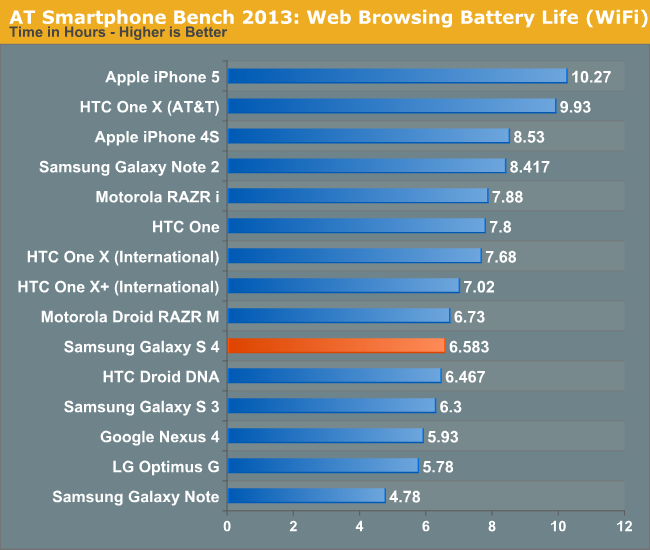
On WiFi the Galaxy S 4 falls behind the HTC One by an appreciable amount, however there's still an improvement in battery life compared to the Galaxy S 3. The Galaxy S 4's battery life isn't bad by any means, but do keep in mind that this is a large phone with a large display and a very powerful SoC. For much of the past year we've been talking about an increase in dynamic range in total platform power of high end smartphones and the Galaxy S 4 is no exception. Run it at full brightness or keep many cores running in their maximum performance states for a considerable period of time and you'll be greeted by a phone that's quickly in need of a power outlet.
As I mentioned earlier, we only have access to the Sprint version of the Galaxy S 4 at this point which unfortunately means that our 3G results aren't all that comparable to other devices here.

Even on Sprint, the Galaxy S 4 does surprisingly well.
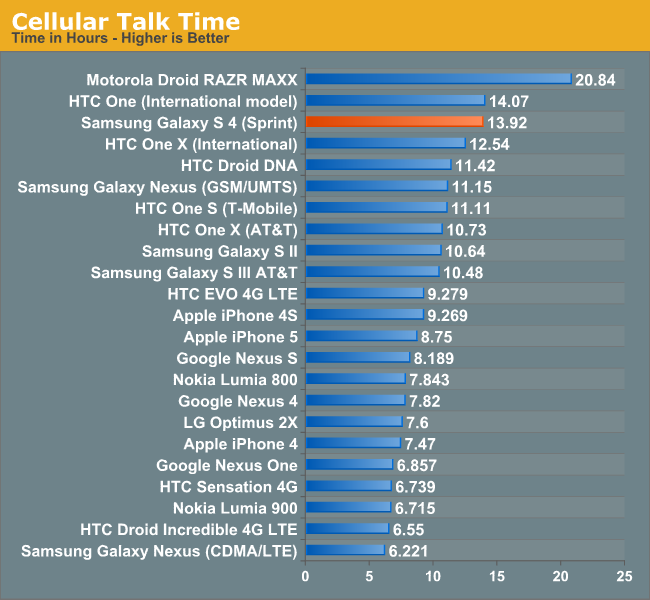
Talk time is excellent on the Galaxy S 4, with the phone delivering effectively the same battery life as the HTC One. Without having to power on that huge display, the Galaxy S 4 can last for a very long time on a single charge.
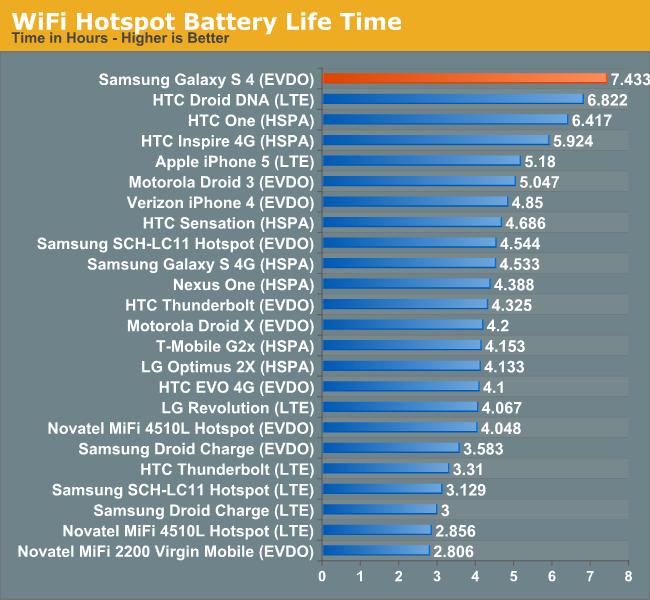
A combination of the Sprint network and the fact that the Galaxy S 4's display remains off during our hotspot test resulted in great battery life here as well. Again, this data isn't all that useful if you're not on Sprint but Samsung tells us we should be able to get our hands on an AT&T SGS4 in the not too distant future.
Charge Time
Samsung appears to implement Qualcomm's Quick Charge specification in the Galaxy S 4 and its bundled charger. I realize we haven't done a deep dive into what Quick Charge is and how it works, but I'll try to go through a quick explanation here. Most conventional chargers are linear, they take a fixed amount of input current (at 5V) and pass it along to the device being charged. The problem is that at deeply discharged states, the device's battery might be at a substantially lower voltage. A traditional linear charger won't change the current supplied based on the voltage of the battery being charged, and as a result can deliver sub-optimal charge times. When implemented, Qualcomm's Quick Charge technology can vary output current based on the voltage of the battery being charged, which results in less power being dissipated as heat and more being delivered to charging the battery itself. The table below helps illustrate the savings:
Quick Charge, at least in its currently available 1.0 specification, is still bound by the 5V limits of the USB BC 1.2 specification. The next revision of Quick Charge will enable higher voltage operation for even faster charge times.
| Qualcomm Quick Charge 1.0, Theoretical Example | ||||||
| Input Current @ Voltage | Input Power | Output Current @ Discharged Battery Voltage | Output Power | |||
| USB BC 1.2 - Linear Charger | 475mA @ 5V | 2.375W | 475mA @ 3V | 1.425W | ||
| Qualcomm Quick Charge 1.0 | 475mA @ 5V | 2.375W | 700mA @ 3V | 2.100W | ||
The non-linear nature of Quick Charge significantly shortens charge time, particularly in the very early stages of charging when the device's battery is presumably fully discharged. As the device's battery voltage increases, current delivery tapers off and the QC advantage is no longer as great as a standard USB BC 1.2 solution. The end result though is significantly improved charge times.
The graph below shows the benefits of using Samsung's own charger vs. a standard charger that implements the USB BC 1.2 specification. When used with the bundled charger, the Galaxy S 4 recharges much faster than HTC's One, despite using a larger battery. Obviously the Galaxy S 4 will charge with any USB charger, but the charge time will simply be longer. Samsung uses a voltage divider and signals the presence of their own charger by sending 1.2-1.3 V across the D+ / D- pins, this is similar to what Apple does with 2.0 or 2.8 V across the pins for various USB chargers they've shipped over the years. This signaling is essentially Samsung's proprietary tablet charging signaling which they've employed on the Galaxy Note 2 and now SGS4, in fact the two use the same exact charger, so it's worth tossing out your old ones and getting the appropriate one to take advantage of the faster charging.
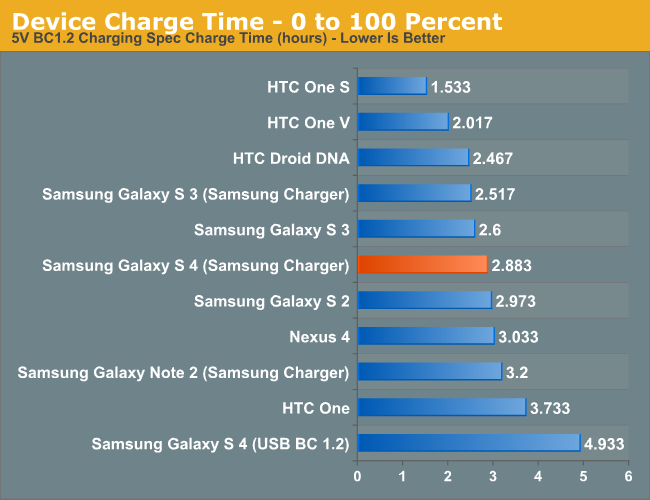


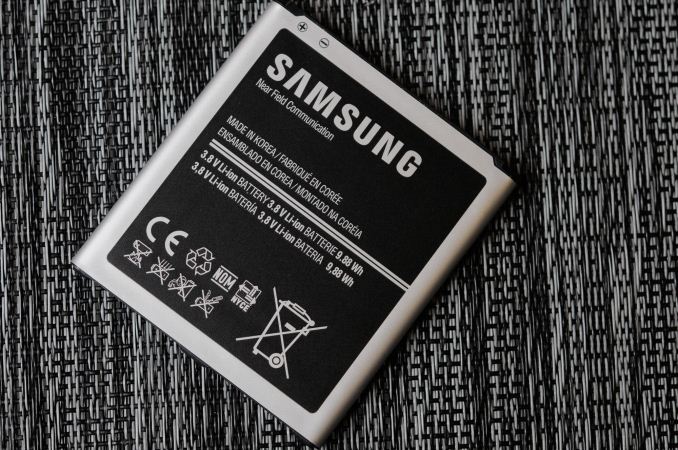








335 Comments
View All Comments
mike55 - Wednesday, April 24, 2013 - link
One of the reasons I am considering the One is because of the camera. 4 MP should be enough for me since I would be viewing it on a 1080p display (2.1 MP) tops. But then I found out the field of view is really large, which would mean I would probably be more likely to crop photos. The images also aren't very impressive in good lightning conditions. It almost looks like it would be a downgrade from my iPhone 4 in terms of photos taken with good lightning. Of course the low light shots would be much better on the One.With the GS4, it feels like the camera is an upgrade in every way, and not just some ways, from my current phone. That, the larger screen, and the fact that the screen is OLED is pushing me towards the GS4. Still conflicted though, haha.
UpSpin - Wednesday, April 24, 2013 - link
I agree, 4MP should be enough, but is the lowest acceptable size. 6MP or maybe 8MP would have been better and safer.The HTC One photos in this review seem to be very blurry and poor compared to the same photos taken for the HTC One review:
http://images.anandtech.com/reviews/gadgets/HTC/HT...
http://images.anandtech.com/reviews/gadgets/Samsun...
I don't know what happened.
The field of view is large, which normally is an advantage, especially indoors. But you're right, outdoors, with the lower resolution it might be an issue.
Regarding OLED: I wrote it in another comment, too. I own a HTC Desire with one of the first OLED screens for smartphones. But also have access to a Galaxy Note with OLED. The colors are stunning, but just false. The max. brightness is poor compared to LCD, so outdoors it becomes more difficult too see the content. OLED consumes more power displaying bright objects (webpages), so much shorter battery life. The sub-pixel size is smaller which shouldn't be an issue any longer at such a high resolution and it also doesn't have pen-tile. The real advantage is that black is almost 100% black which is great :-) The disadvantages however are huge, and while I still like OLED technology and also use simpler OLED displays in my own projects, I think it's just inferior to LCD in smartphones right now. (see this review highlighting some issues). But the screen is larger, another advantage for the S4. Sad that the One has such a huge bezel.
Silellak - Wednesday, April 24, 2013 - link
The difference is likely that the camera was set to default or -1 Sharpness in the original HTC One photo and -2 sharpness in this review.gnx - Wednesday, April 24, 2013 - link
If my memory is correct, the OLED in HTC Desire was from CMI, not Samsung, so I'd think slightly inferior. That said, from all I can gather, AMOLED is still a technology in progress, each generation better than the last, though still with some trade-offs compared to the much more mature LCD. If there is one console, Samsung leads the OLED development, with it's Super AMOLED screens, so if you decide to stick to OLED, at least you know you're getting the best OLED out there with the SGS4.nerd1 - Wednesday, April 24, 2013 - link
4MP is not enough, unless the sensor is Foveon.DroidTomTom - Wednesday, April 24, 2013 - link
Button layout. That is my biggest gripe with the HTC One. The power button should never be on the top. I hated it on my Palm PDAs and on every smartphone I have had since. My Galaxy S has a button layout that just works.creathir - Wednesday, April 24, 2013 - link
Brian, the HTC's audio is flat out amazing.How is the audio on the GS4?
Are you planning on doing audio tests in the future? I know compared to my iPhone 5, the One blows it completely out of the water.
Toss3 - Wednesday, April 24, 2013 - link
Are you talking about headphone performance or external speakers?creathir - Wednesday, April 24, 2013 - link
External speakersscaramoosh - Wednesday, April 24, 2013 - link
How is plastic a downside? It's much better than dented scratched up metal that you'll have to wrap in a plastic case to protect it anyways. Just find it funny how the only two times people see their metal phones is when they buy it and when they sell it, the rest of the time it's in a stupid case. Having to buy a case alone is proof that metal isn't a good material for a phone.I dropped my Nokia, what did I do? Bought a new back cover, replaced it. What will I do with the One if I did the same? Oh, I'm fucked unless I want to pay HTC hundreds to fix it and be without a phone for a month.